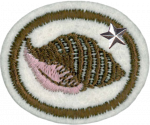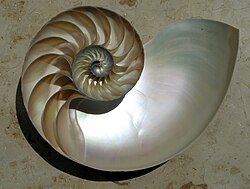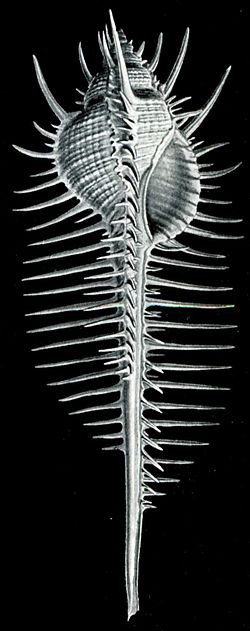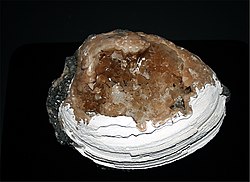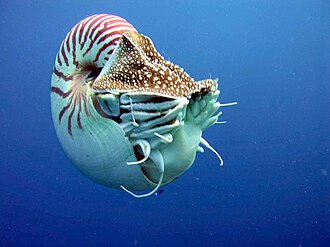Especialidades JA/Moluscos - Avanzado/Respuestas
| Moluscos - Avanzado | ||
|---|---|---|
| Asociación General
|
Destreza: 3 Año de introducción: 1949 |
|
Requisitos
1
Para consejos e instrucciones, véase Moluscos.
2
3
There are ten classes of molluscs; eight of the classes have living representatives, the other two classes are known only from fossils. More than 250,000 species of mollusc are recognized and named. Snails (Gastropoda) account for about 80% of living mollusc diversity.
4
4a
4b
4c
4d
4e
4f
5
5a
5b
5c
5d
5e
5f
5g
The operculum, meaning little lid, (plural: opercula or operculums) is a corneous or calcareous structure which exists in some groups of marine, freshwater, and land snails or gastropods. It is present in most but not all gastropods that have shells and gills. Pulmonate snails do not have opercula, but some terrestrial species are capable of secreting an epiphragm.
In its most typical condition, an operculum serves to close the opening or aperture of the shell when the soft parts of the animal are withdrawn into the shell.
An operculum can vary in shape greatly from one family of gastropods to another, but an operculum is fairly often circular, or more or less oval in shape. In species where the operculum fits snugly, its outline corresponds exactly to the shape of the aperture of the shell.
5h
Nacre, also known as mother of pearl, is an organic-inorganic composite material produced by some molluscs as an inner shell layer. It is exceptionally strong, resilient, and iridescent. Nacre is found in some bivalves, some gastropods and some cephalopods. The inner shell layer in most molluscs however is merely porcellaneous, in other words shiny like a china plate, not iridescent.
Pearls and the inside layer of the pearl oyster shells and the freshwater pearl mussel shells are made of nacre. Many other families of molluscs also have an inner shell layer which is nacreous, including gastropods such as the Haliotidae, the Trochidae and the Turbinidae.
5i
The epidermis is the outermost layer of the mantle. In many, but by no means all, species of molluscs, the epidermis of the mantle secretes calcium carbonate and creates a shell.
5j
Ribs are strong, well-defined ridges on the surface of the shell.
5k
The radula is a toothed chitinous ribbon which is present in the mouth of most but not all classes of molluscs. It does not exist in any phyla other than the Mollusca.
The radula is usually used for scraping, cutting and chewing food before it enters the esophagus. It is present in all classes of molluscs except the bivalves.
5l
Concentric lines are circular growth rings on the outside of a shell. Concentric rings are circles of different diameters having a common center. Characteristics of the concentric lines (spacing, definition, etc.) can be used as an aid to identifying a mollusc.
5m
In some sea snails, (marine gastropod molluscs in the infraorder Neogastropoda), the animal has an anterior extension of the mantle called a siphon, through which water is drawn into the mantle and over the gill. This siphon is a soft fleshy tube which also serves to "smell" or "taste" the water in order to locate a possible source of food.
In many (but not all) neogastropods where the siphon is particularly long, the structure of the shell has been modified in order to house and protect the soft structure of the siphon. Thus the siphonal canal is a semitubular extension of the aperture of the shells of some marine gastropods, through which the siphon is extended when the animal is active.
5n
Spines are sharply pointed spurs protruding from a mollusc's shell. Murexes and conches have prominent spines.
5o
A whorl is a single, complete 360° turn in the spiral growth of a mollusc shell. A mollusc shell is basically a long tube, usually coiled in a spiral for strength and compactness. The number of whorls in the shell depend on various factors in the geometric growth.
The number of whorls differs in various groups, with the family Turritellidae having very high spired shells with a large number of whorls and hence a relatively small aperture.
- Apical whorls—those whorls near the apex or tip of the shell.
- Body whorl—The most recently formed whorl of a spiral shell.
- Nuclear whorl(s)—small, generally smooth whorls formed within the egg and constituting the apex of the shell.
- Protoconch—a larval shell of a mollusc; also refers to protoconch whorls of an adult shell.
- Teleoconch—all the whorls of a shell after the protoconch whorls.
5p
Lips are the curled section of shell surrounding the aperture. Lips can curl outward, as with the conch, or inward, as with the cowrie.
6
In those molluscs which have a shell, the shell grows gradually over the lifetime of the mollusc by the addition of calcium carbonate to the leading edge or opening, and thus the shell gradually becomes longer and wider, in an increasing spiral shape, to better accommodate the growing animal inside. The animal also thickens the shell as it grows, so that the shell stays proportionately strong for its size.
A mollusc shell is formed, repaired and maintained by a part of the anatomy called the mantle. Any injuries to or abnormal conditions of the mantle are usually reflected in the shape and form and even color of the shell. When the animal encounters harsh conditions which limit its food supply, or otherwise cause it to become dormant for a while, the mantle often ceases to produce the shell substance. When conditions improve again and the mantle resumes its task, a "growth line" which extends the entire length of the shell is produced, and the pattern and even the colors on the shell after these dormant periods are sometimes quite different from previous colors and patterns.
Interestingly, within some species of mollusc there is often a surprising degree of variation in the exact shape, pattern, ornamentation, and color of the shell.
The longest lived mollusc is the Arctica islandica (Ocean Quahog). Animals of this species close to 400 years old are not uncommon.
7
The West Indian Fighting Conch is an aggressive sea snail with a nasty sting which it uses to defend itself against marine predators. These shells are best collected when the tide goes out, as great numbers of them suddenly emerge from the sand and retreat to the surf. If one is flipped over, it can right itself using its sharp operculum.
8
9
molluscs have few requirements in order for them to thrive. They need moisture, but if they find themselves in a dry environment, they are able to seal themselves (and their moisture) inside their shells until external moisture becomes available again. Thus, molluscs can be found in nearly every habitat on Earth - even deserts!
10
11
11a
The muscles of both types of molluscs attach directly to the shell. These animals (including snails) cannot leave their shells and return any more than a turtle can leave its shell. The shell serves as the animal's skeleton.
11b
The outer edge of a mollusc's mantle contains glands that secrete color pigments during shell formation. These pigments control the colors on the outside of the shell. The iridescence on the inside of the shell is caused by alternating layers of calcite and aragonite refracting different wavelengths of light by different amounts depending on the viewing angle.
11c
The 'Nautilus has two pairs of gills (that's four!).
11d
Cuttlefish have ink, like squid and octopuses. This ink was formerly an important dye, called sepia. Today artificial dyes have replaced natural sepia.
11e
Several molluscs spin a byssus which is used to anchor them to a substrate. These include mussels in the family Mytilidae and the zebra mussel (Dreissena polymorpha). However, the mollusc with perhaps the most extensive byssus is the rigid pen shell (Atrina rigida). Like most pen shells, A. rigida lives in soft bottoms, with the majority of the shell buried, point down, leaving only a few inches exposed, held in place by an extensive net of byssal threads.
11f
Many people find the very rounded, shiny, porcelain-like shells of cowries pleasing to look at and to handle. Shells of certain species have historically been used as currency in several parts of the world, as well as being used, in the past and present, very extensively in jewelry, and for other decorative and ceremonial purposes.
11g
Tibetan Buddhists make use of a particular set of eight auspicious symbols, ashtamangala, in household and public art. The chank shell or conch is one of these eight symbols:
- Conch
- Knot
- Fish
- Banner
- Lotus
- Parasol
- Urn
- Wheel
11h
Hexaplex trunculus (also known as Murex trunculus or the banded dye-murex) is a medium-sized species of sea snail.
This species of sea snail is important historically because its hypobranchial gland secretes a mucus that the ancient Canaanites/Phoenicians used as a distinctive purple-blue indigo dye. One of the dye's main chemical ingredients is indigotin, and if left in the sun for a few minutes before becoming fast, its color turns to a blue indigo (like blue jeans).
11i
Nacre, also known as mother of pearl, is an important part of the shell structure in many gastropod and bivalve molluscs especially the more ancient families such as top shells and pearl oysters. Like the other calcareous layers of the shell, the nacre is created by the epithelial cells (formed by the germ layer ectoderm) of the mantle tissue. mollusc blood is rich in dissolved calcium, and during shell deposition, the calcium is concentrated out from the blood and crystallized as calcium carbonate. Nacre is continually deposited onto the inner surface of the animal's shell (the iridescent nacreous layer or mother of pearl). This is done both as a means to thicken, strengthen and smooth the inner surface of the shell itself and as a defense against parasitic organisms and damaging detritus.
When a mollusc is invaded by a parasite or is irritated by a foreign object that the animal cannot eject, a process known as encystation entombs the offending entity in successive, concentric layers of inner shell material, which in some cases is nacre. This process eventually forms what we call pearls and continues for as long as the mollusc lives. Almost any species of bivalve or gastropod is capable of producing "pearls", even molluscs which have no inner nacreous layer. However, only a few species, such as the famous pearl oysters, can create pearls which are highly prized.
12
- Musical Instruments
- Key touches and various decorations on musical instruments such as saxophones, trumpets, violins, banjos, tamburitzas and guitars are sometimes made of mother of pearl. It is used as inlays on many guitar fretboards.
- Clothing
- Mother of pearl buttons can be found on a variety of clothing such as shirts, skirts and coats.
- Decorative Inlays
- Nacre is also used as a decorative feature of watch faces, knives, guns and jewelry.
- Building Material
- Instead of using a marble or tile base, the mother of pearl tesserae can be glued to a fiberglass mesh. The result is a lightweight material that offers a seamless installation, and there is no limit to the sheet size. Mother of pearl sheets may be used on interior floors, exterior and interior walls, countertops, doors and ceilings. Insertion into architectural elements, such as columns or furniture is easily accomplished. Conch shells are occasionally used as a building material, either in place of bricks or as bulk for landfill.
- Jewelry
- Pearls are highly prized jewelry components.
- Souvenirs
- In some countries, cleaned Queen Conch (Strombus gigas) shells or polished fragments are sold, mainly to tourists, as souvenirs or in jewelry. Without a permit, however, export is a breach of CITES regulations and may lead to arrest. This is most likely to occur on return to the tourist's home country while clearing customs. In the UK conch shells are the ninth most seized import.
- Pets
- Snails are often kept in aquariums along with fish.
13
- a. Personalmente encontrar y recolectar 40 especies de conchas que representan a las cinco clasificaciones. Hacer una lista de cada molusco con el lugar y la fecha en que fue encontrado, nombre común, nombre científico y la clase.
- b. Hacer una colección de 50 especies de conchas que ha encontrado, recibido o comprado que representen las cinco clasificaciones.
- Hacer una lista de cada concha recogida de la siguiente manera: si la encontró personalmente, dar la información solicitada en el punto «a»; si la recibió o compró, dar el nombre de la persona de quien recibió la concha, el hábitat de la concha, la fecha de su adquisición, su nombre común, nombre científico y la clase.
The best approach here is to get a good field guide and then try to identify the shells you have found.
The five classifications of seashells are:
- Gastropoda
- (snails, conches, etc.)
- Cephalapoda
- Such as Spirula spirula. Although the whole animal is rarely seen, the internal shell is very light and commonly floats ashore on beaches. The internal shell of this animal is known as the "ram's horn shell".
- Bivalvia
- (clams, mussels, etc.)
- Polyplacophora
- (chitons)
- Scaphopoda
- (tusk shells)
If you opt to purchase your collection, one possibility is to start with a kit containing specimens from all five of these classes. Seashells.com carries a such a kit, reasonably-priced.
References
- http://depts.washington.edu/natmap/mollusks/glossary.html
- http://www.informaworld.com/smpp/content~content=a793157051~db=all~jumptype=rss
- http://seachestsecret.questacon.edu.au/assets/Delve_Deep_-_Pearl_Oysters.pdf
- Categoría: Tiene imagen de insignia
- Adventist Youth Honors Answer Book/Honors/es
- Adventist Youth Honors Answer Book/es
- Adventist Youth Honors Answer Book/Skill Level 3/es
- Categoría: Libro de respuestas de especialidades JA/Especialidades introducidas en 1949
- Adventist Youth Honors Answer Book/General Conference/es
- Adventist Youth Honors Answer Book/Nature/es
- Adventist Youth Honors Answer Book/Nature/Primary/es
- Adventist Youth Honors Answer Book/Stage 0/es
- AY Honors/Prerequisite/Shells/es
- AY Honors/See Also/Shells/es
- Adventist Youth Honors Answer Book
